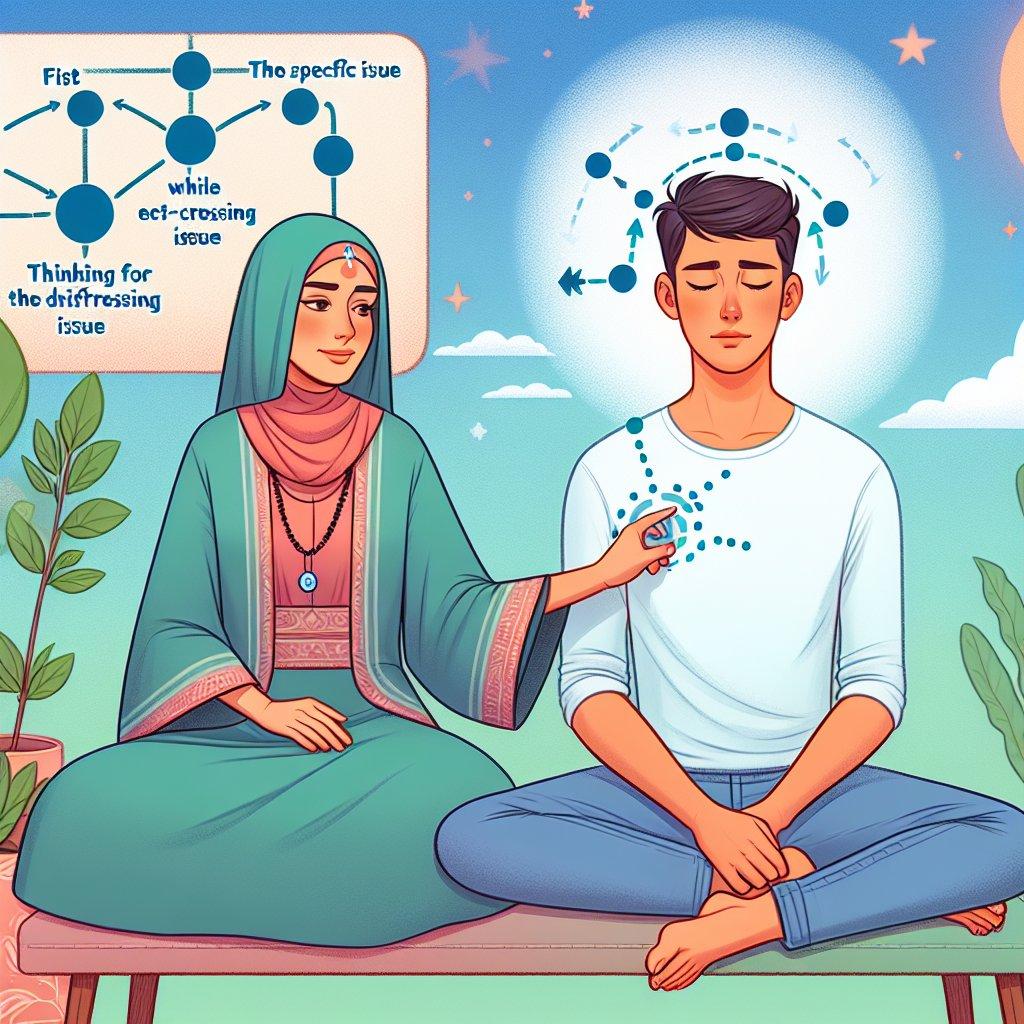Thought Field Therapy (TFT) is a novel method that aims to reduce emotional suffering by using a distinctive blend of psychological approaches and acupressure. This treatment practice aims to address underlying psychological triggers by tapping on certain meridian points while focusing on emotional concerns.
The Role of Thought Field Therapy in Emotional Healing

Thought Field Therapy is a distinctive method in the field of psychological healing and emotional well-being. It operates on the belief that negative emotions and psychological problems can be effectively resolved by accessing the body’s natural energy system, similar to practices in Traditional Chinese Medicine.
Thought Field Therapy practitioners aim to alleviate mental distress and discomfort by targeting specific tapping or acupressure points on the body. This technique involves focusing on distressing memories or emotions in order to identify and neutralize the underlying emotional triggers. By doing so, they strive to promote a sense of relief and emotional balance.
During therapy, individuals are instructed to identify the precise thoughts or emotions that contribute to their emotional distress. At the same time, they gently tap on specific meridian points, which helps to release any energetic blockages that may be causing their distress. The complex interconnection between thought and energy serves as the foundation of Thought Field Therapy, enabling a route for emotional recovery that incorporates both cognitive and somatic components.
Moreover, the effectiveness of Thought Field Therapy is based on its thorough comprehension of human psychology and emotional processing. It not only helps individuals in relieving their immediate distress but also enables them to gain profound understanding of their emotional patterns and triggers. This ultimately results in enduring transformation and personal development.
Thought Field Therapy enhances individuals’ ability to negotiate life’s problems and gives them with tools to address future emotional upheavals by boosting self-awareness and emotional resilience. As individuals engage in the practice, they may discover that the advantages go beyond only alleviating symptoms, transforming their connection with their emotions and improving their entire well-being.
Exploring The Emotional Triggers In Thought Field Therapy

Thought Field Therapy (TFT) is a remarkable method for treating psychological problems by spotting and controlling particular emotional triggers that might impede a person’s general emotional well-being; this sophisticated knowledge of emotional responses helps certified practitioners to design customized treatment plans, so enabling clients to negotiate their psychological terrain with more ease and effectiveness.
TFT practitioners can start a transforming process by exploring the depths of one’s past events and identifying the natural relationships between specific stimuli and emotional responses, so enabling people to recover control over their emotional health and negotiate life’s challenges with fresh resilience and insight.
Awareness of Emotional Triggers
Through the prism of Thought Field Therapy, emotional triggers—which, in many cases are disproportionate to the current situation—are not only byproducts of one’s environment but rather often closely relate to unresolved problems from the past or even inherited emotional responses that have persisted through generations.
Clients may find it helpful to share their experiences when they start to identify these triggers during their TFT sessions since vocalizing feelings may often be a cathartic release that creates the path to more profound knowledge and healing. Furthermore, spotting these particular triggers becomes essential as they are the means to release emotional freedom by letting people face and handle these problems head-on instead of letting them keep affecting their conduct negatively.
TFT’s Approach to Handling Triggers
Using Thought Field Therapy, practitioners may guide clients to tap on particular meridian points while simultaneously concentrating on the identified emotional triggers, so promoting a physiological and psychological release of tension connected with those emotions by a delicate interaction of cognitive awareness and physical interventions engaging the mind and body.
This double approach not only assists clients to release the negative energy connected with their triggers but also gives them tools to process their emotions more sensibly, therefore opening the path for long-term emotional resilience and sustainable development. By means of TFT, repeated engagement with these emotional triggers over time can cause desensitization to their once-overpowering effects, so providing a route for individuals to recover their emotional stability and welcome a more fulfilling life free of the constraining influences of their past traumas.
Techniques Used To Apply Thought Field Therapy

One of the main foundations of TFT is the practice of tapping on particular acupressure points on the body that correspond to emotions related with stress or trauma; this tactile stimulation is meant to help release negative emotions, so promoting a resolution of the particular current issue under hand. Usually using a tailored story that increases the therapeutic engagement, the method may comprise a sequence of tapping at important times as practitioners help clients through their emotional triggers, therefore producing both immediate relief and long-term emotional resilience.
Often used in order to demonstrate Thought Field Therapy’s approach are the following:
- Diagnostic Formulation: Therapists begin by identifying the specific issue or emotional distress the client is facing.
- Tapping Sequence: Once the problem is defined, a preset series of tapping points are engaged in a particular order.
- Affirmation Statements: Clients articulate personal affirmations that resonate with their emotional state while they follow the tapping sequence.
- Visualizations: Imagery and visualization exercises may be included to help clients mentally navigate through their issues.
- Final Assessment: After the tapping sequence, therapists assess the effectiveness of the session by revisiting the emotional intensity of the problem.
How Thought Field Therapy Addresses Emotional Distress?

Thought Field Therapy shines in helping people take control of their emotional experiences since when people experience emotional pain it can often show up as anxiety, depression, or physical symptoms, so creating a situation in which one feels overwhelmed and unable to effectively manage their emotions or the external circumstances surrounding them. By means of its straightforward yet powerful methods, TFT enables clients to investigate their emotional triggers and therefore promote a sense of autonomy and resilience that can drastically change their emotional terrain for the better.
| Benefits of Thought Field Therapy | How It Works |
|---|---|
| Addresses root causes of distress | Utilizes tapping on acupuncture points |
| Promotes emotional healing | Focuses on specific emotional issues |
| Quick relief from anxiety and stress | Restores emotional balance |
| Supports personal empowerment | Encourages self-awareness and growth |
Thought Field Therapy not only addresses emotional pain at its core but also provides continuous support and tools for those wishing to keep emotional health long after the first therapy sessions have ended. By using these techniques into daily life, clients often find they can control their emotions more effectively and negotiate life’s challenges with fresh clarity and strength. Moreover, as many anecdotal stories and new studies highlight the efficacy of TFT, it is evidence of the need of alternative therapeutic approaches for treating emotional pain in our modern society since they enable people to re-connect with their emotional selves and offer a road for healing and self-discovery.
- Identifying emotional triggers through guided sessions
- Practicing specific tapping techniques for relief
- Building emotional resilience over time
The Role Of Visualization In Enhancing Therapy Results

Within the field of therapeutic approaches, especially in relation to Thought Field Therapy (TFT), the integration of visualization is a useful tool that improves the efficacy and general results of the therapeutic process by letting people create mental images that really relate to their emotional states, so enabling a more strong connection with their inner experiences.
When clients visualize, they actively create and control scenarios in their minds, so evoking a range of emotions and facilitating their exploration of the depths of their feelings and identification of particular triggers that might have gone unnoticed in past times. They are not only remembering memories or events. Thus, visualization is a key component of the set of instruments applied in TFT since it helps to close the distance between cognitive knowledge and emotional release.
- Helps one have a closer emotional relationship with events.
- Helps find and deal with particular emotional triggers.
- Improves focus and relaxation during therapy.
One of the main advantages of using visualization in Thought Field Therapy is its capacity to promote relaxation since seeing peaceful images or pleasant scenarios usually helps clients to lower anxiety and create a more suitable mental environment for therapeutic work, whereby they can explore their emotions without overwhelming discomfort.
Moreover, the process of imagining good results can energize clients, therefore inspiring an optimism and drive that might otherwise be difficult to build during times of emotional upheaval. Along with helping one heal, this empowerment strengthens their confidence in their capacity to overcome obstacles—a vital component of the therapeutic process.
| Visualization Techniques | Benefits |
|---|---|
| Create a safe space in imagination | Encourages relaxation and security |
| Imagine a favorite place or memory | Evokes positive emotions and reduces stress |
| Visualizing successful outcomes | Promotes confidence and builds resilience |
Clients typically describe major changes in their emotional landscapes as they learn to use visualization, which results in a fresh clarity and comprehension of their emotions and finally helps to make a therapeutic effort more successful.
Visualizing in TFT also depends on the client’s willingness to actively participate in the process; hence, therapists are quite important in guiding clients through this visual journey and motivating them to investigate their mental images with both curiosity and compassion. Between Thought Field Therapy and the craft of visualization, we discover a great synergy that helps people on their road toward emotional well-being and recovery.
Frequently Asked Questions
Who created Thought Field Therapy?
Dr. Roger Callahan created Thought Field Therapy in the 1980s as a technique for addressing a range of emotional problems.
How may Thought Field Therapy be beneficial?
TFT is thought to help the body’s energy balance be restored by tapping on precise acupressure sites while concentrating on a given emotional concern.
Typical Thought Field Therapy sessions last how long?
Depending on the particular needs of the person, a normal TFT session can go anywhere between thirty and sixty minutes.
Is Thought Field Therapy something anyone might do?
Although everyone can pick the fundamentals of TFT, it is advised that practitioners go through official training to properly apply the method to treat patients.